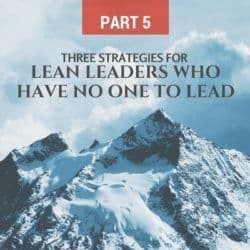 Mark's note: Here's the concluding post in a series by a guest blogger, Paul Serafino. You can click here to read earlier posts in this series about leaders who have no one to formally lead. Thanks to Paul for his contributions!
Mark's note: Here's the concluding post in a series by a guest blogger, Paul Serafino. You can click here to read earlier posts in this series about leaders who have no one to formally lead. Thanks to Paul for his contributions!
Here is a PDF ebook created by Paul with the entire series.
Conclusion:
After trying out these strategies, you'll have formed a couple new (and interesting) teams, started developing a loyal sidekick that drives ideas (and you) forward, and created some memorable events that produced real results.
Think back to the examples of the over-stated job descriptions and elaborate titles that all exist to describe the same person, the one responsible for “doing Lean” or “improving the process.” Imagine if the previous paragraph was copied and pasted into your current HR file. It's a decent start, right?
Now imagine adding some of the following to your performance summary, or LinkedIn profile:
Impact you have on your peers
- Leverage their individual purpose to build knowledge-sharing relationships for results
- Cleverly teach (without teaching) and train (without training) – they engage willfully
- Encourage and guide unlikely teams to influence up, together, giving them confidence
Impact you generate for the company
- Develop stronger, more capable people that autonomously improve their work
- Turn enthusiastic followers into problem solving leaders
- Translate productivity improvements as cost reductions
(Bonus: management LOVES cost reduction)
- Engage customers in more proactive conversations instead of reacting to complaints
(Bonus: management HATES customer complaints)
- Amass a solid list of future “project” ideas (Bonus: management LOVES roadmaps)
And,
- Improve Safety, Quality, and Delivery (Huh? Yes, after all that's the whole point!)
All of the other intangible benefits are not the end game. They are the means by which you accomplish the basic, fundamental business improvements that many leaders struggle to do because their plans typically contradict the Lean principles.
- They fight the customer and stand by their features-proposition instead of finding the value-proposition their market really needs.
- They see meetings and ERP (and other flow disrupters) as solutions to production problems, and promote PUSH from the beginning as the only way to get more out at the end.
- Rather than embracing perfection as competition, they play with pricing and benchmarking to learn what others are doing and aim to be just a few points better in order to “win” business.
As a Lean Program Manager or Continuous Improvement Facilitator (or whichever title you've adopted), you can't change the rules of their game. Not without sacrificing your sanity (or possibly your job). Instead, play within the rules but own the snap counts and audibles. Approach the line of scrimmage as if the only goal is a first down.
You can't do it alone, so apply the strategies outlined above to execute incredible play after incredible play. Before you know it, you'll string together a memorable scoring drive, and put meaningful points on the board.
That's how you'll secure your starting position on the roster and fuel the organization's forward progress. Executives (like team owners) will take notice and be your loudest supporters (mainly because in their minds you're doing it their way).
But you'll know the truth, and that secret is safe.
Download Paul's Free eBook:
What do you think? Please scroll down (or click) to post a comment. Or please share the post with your thoughts on LinkedIn – and follow me or connect with me there.
Did you like this post? Make sure you don't miss a post or podcast — Subscribe to get notified about posts via email daily or weekly.
Check out my latest book, The Mistakes That Make Us: Cultivating a Culture of Learning and Innovation:










